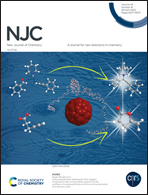A natural cyanobacterial protein C-phycoerythrin as an Hg2+ selective fluorescent probe in aqueous systems†
Abstract
A natural, yellow fluorescent cyanobacterial protein, C-phycoerythrin (CPE), was purified from a marine cyanobacterium Lyngbya sp. to a purity ratio of 5.17 using ammonium sulphate precipitation and column chromatographic techniques. After characterization by UV-visible and fluorescence spectroscopy, it was found to selectively detect micromolar quantities of Hg2+ among 12 biologically significant metal cations through the fluorescence ‘turn off’ phenomenon. Sequential titration of CPE with Hg2+ revealed a minor hypsochromic and a major hypochromic shift in its absorbance maximum and significant fluorescence quenching above 2 μM Hg2+. The response of CPE towards Hg2+ was instantaneous and unaffected by high concentrations of other cations except Cu2+. CPE was able to selectively detect and quantify Hg2+ in pond, tap and effluent water samples with recovery % of ∼94.8–107.5%. FT-IR analysis suggested Hg2+ interactions with –NH regions in the protein. Thus, CPE could be further explored as a natural agent for the selective detection of biologically and environmentally hazardous Hg2+ through the fluorescence ‘turn off’ route.



 Please wait while we load your content...
Please wait while we load your content...